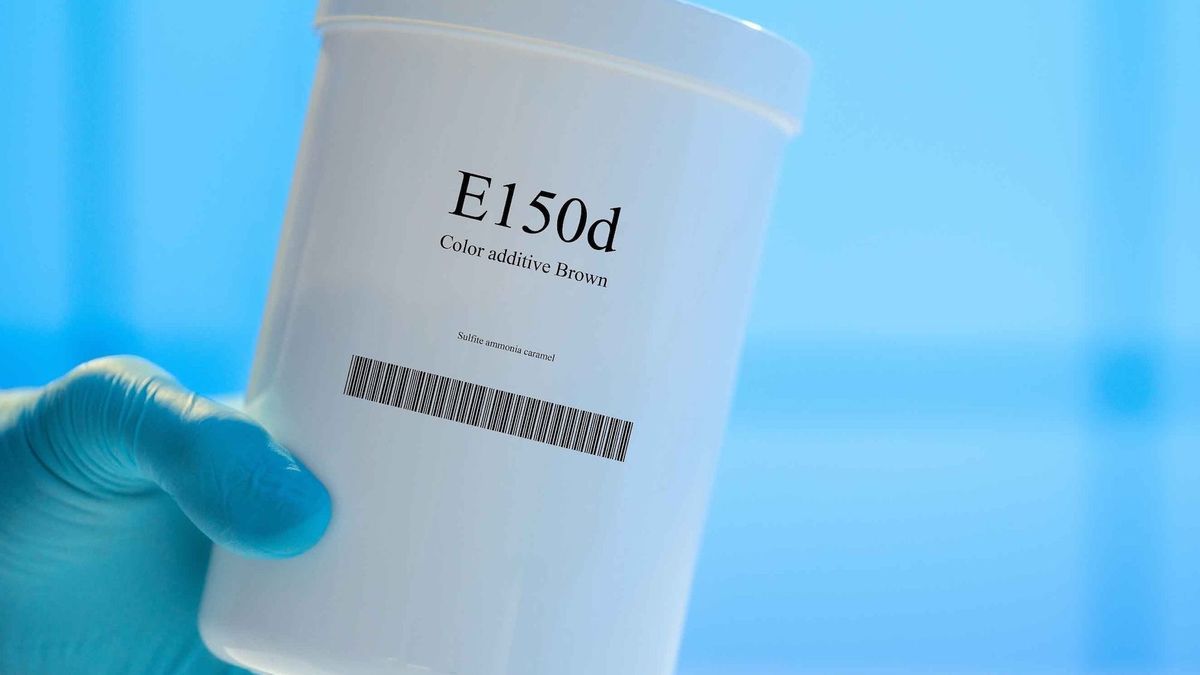
This additive which gives foods a pretty caramelized color, is unfortunately not snow white. Also known as ammonium sulphite caramel, E150D is one of the additives to avoid and look out for on packaging. Anthony Fardet, researcher in preventive and sustainable nutrition and author of “Stop ultra-processed foods!” published by Thierry Souccar and Claudine Plumail, dietician and nutritionist, tell us about this controversial food coloring.
What is E150D, ammonium sulfite caramel coloring and what does it do?
The E150D additive is a coloring which is part of the E150 family or “caramel” family which has four representatives: E150A, E150B, E150C and E150D. E150A is simple caramel, therefore without health risk but very little used in industry, E150B adds the use of sulphite, E150C ammonia and E150D combines both. “E150D or ammonium sulphite caramel is mainly used as a coloring (more or less dark brown) in liquid foods. For carbonated drinks, it also provides stability by avoiding the formation of deposits at the bottom of the bottle. Finally, in the case of liquids packaged in glass bottles, it prevents oxidation of the liquid by light” explains Claudine Plumail.
Additives can be classified into two main categories: “cosmetics” which include all texturizers, emulsifiers, colorings and taste modifiers, and “preservatives” useful for the good preservation of food. “Cosmetic additives, by definition, are not essential and artificially modify the color, texture and taste properties of foods. Their presence in a food testifies to its degree of processing. The more there are, the more the food is processed. The E150s are one of them. Preservative or antimicrobial type additives are not markers of ultra-processing – even if some can pose problems like nitrites – they are used to optimize the conservation of an industrial food” explains Anthony Fardet.
Balsamic vinegar, cola: in what foods is it found?
E150D is mainly added to give a brown or golden hue to foods and drinks. It is found in particular in sodas and soft drinks, particularly colas, in iced teas, ginger ale drinks, in sauces (barbecue, for salads, for pasta and soy sauces), amber beers and vinegars. balsamic. Candies, chocolates, chocolate bars and confectionery containing caramel or having a caramel flavor may also contain this additive to enhance their color and taste.
How are food additives classified?
Food additives are classified into 9 categories depending on their role:
- Food colorings, which can be of natural or synthetic origin;
- Preservatives to extend their shelf life;
- Antioxidants to prevent the oxidation of fats in foods;
- Sweeteners to give a sweet flavor to foods without adding sugar;
- Emulsifiers to stabilize mixtures of ingredients;
- Texturing agents (thickeners, gelling agents, stabilizers and bulking agents);
- Flavorings and flavor enhancers;
- Acidifiers to regulate acidity;
- Leavening agents added to baked goods to help dough rise.
Is this additive Halal or haram?
E150D is a brown food coloring of plant origin, and is therefore compatible with a halal, kosher or vegetarian diet.
NO to diets, YES to WW!
Cancer, ADHD: What effects on health and is it carcinogenic?
Although declared “neither genotoxic nor carcinogenic for humans“by the EFSA (European Food Safety Authority), there is no consensus on the safety of E150D on human health. According to the magazine Que Choisir”E150d may contain a newly formed compound, 4-MI (4-methylimidazole) suspected of being carcinogenic and classified C2b by the International Agency for Research on Cancer“. It is thus listed in the category of additives “to be avoided”. For this reason, European regulations have set for all caramels an acceptable daily intake (ADI) 100 times lower than the maximum ingested dose which does not produce toxic effects.
“But just because an additive alone poses little or no health problem does not mean that its consumption is safe. Combined with other additives, it can become problematic: this is what we call the cocktail effect. Furthermore, we have no scientific perspective on the long-term health effects.” indicates Anthony Fardet, for whom the consumption of any so-called cosmetic additive must be limited as much as possible. “For example, we have observed that a 6-year-old child could easily absorb up to 40 additives per day, between biscuits and industrial snacks, sodas, breakfast cereals and prepared meals. It's huge, the stakes are very high” adds the expert.
Several scientific studies have also observed a link between the consumption of synthetic food colorings (of which E150 is one) and symptoms of ADHD in children.
This caramel coloring should also be avoided in case of intolerance to sulphites.
What additives are prohibited?
Food additives that are not explicitly authorized in Europe are considered prohibited. The list is therefore non-exhaustive since currently, 320 additives are authorized in Europe, while – for example – some 450 are authorized in Canada. The list of additives authorized in Europe is available on the website of the Ministry of Agriculture and Food Sovereignty.

